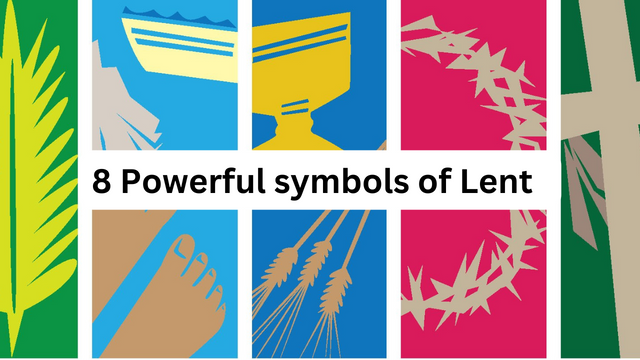8 Powerful symbols of Lent

Did you know that the Lent season is also rich in symbolism? From the ashes used on Ash Wednesday to the palms on Palm Sunday, each symbol has a unique meaning that adds depth and significance to the season. Let’s explore the rich symbolism that makes Lent such a meaningful and transformative time of year.
History of lent
The history of Lent can be traced back to the early Church, where it was established as a time of preparation for new converts to the faith Over time, Lent became a season of penance and self-reflection for all Christians, as they tried to imitate the forty days that Jesus spent fasting in the wilderness before beginning his public ministry. Today, Lent is observed by Christians of many denominations around the world, with each group celebrating the season in its unique way.
8 Lent symbols and their meanings
In the Christian calendar, Lent is a period of serious reflection and preparation leading up to Easter. Symbols play an important role in this season, each holding a unique meaning that enhances the overall message of Lent.
1. Ashes
Ash Wednesday, which marks the beginning of Lent, is named after the practice of marking one’s forehead with ashes shaped like a cross. It symbolizes repentance and humility and the temporary nature of human life. In ancient times, the ashes served as a symbol of mourning and repentance. This further emphasizes the cycle of life, death, and rebirth, as the same palm branches used to celebrate Jesus’ entry into Jerusalem were later burned and used to remind us of mortality and the need for repentance.

2. Purple
Purple is the traditional color of Lent and represents penance, sorrow, and royalty. During the season of Lent, priests and altar cloths are draped in purple to mourn the death of Jesus and remind him of the sacrifices he made. The purple color also symbolizes the royalty of Jesus as the King of Kings. In addition, purple also has a deep symbolic meaning in Lent. The use of purple during Lent dates back to ancient times when purple was a rare and expensive dye reserved for royalty and the wealthy.

3. Crown of Thorns
The crown of thorns is a symbol of the suffering that Jesus endured on the cross. It is said to have been made from thorns found in the Garden of Gethsemane and placed on the head of Jesus during his crucifixion. The crown of thorns reminds us of the price Jesus paid for our salvation. The Crown of Thorns is also an important relic in Christianity, with many purported pieces of the crown kept in churches around the world. One of the most famous of these is the Crown of Thorns, housed in Notre Dame Cathedral in Paris, believed to be the actual crown worn by Jesus during his crucifixion.

4. Palm branches
Palm Sunday marks the beginning of Holy Week, commemorating Jesus’ entry into Jerusalem before his crucifixion. The crowd greeted him by waving palm branches, which were a symbol of victory and triumph. Palm branches are still used in many churches today to commemorate the triumphal entry of Jesus on Palm Sunday. In addition to their use on Palm Sunday, palm branches have also been used as symbols of martyrdom and sacrifice in Christianity. In some parts of the world, Christians carry palm branches with them when participating in processions or attending church services during Holy Week.

5. Cross
The cross is the most recognizable symbol of Christianity and a powerful reminder of Jesus’ sacrifice. During Lent, many Christians wear a cross as a symbol of their faith and a reminder of the sacrifice Jesus made for them. The symbol of the cross has a rich history in Christianity and is thought to have been used as a symbol of faith as early as the 2nd century. It was not until the 4th century, however, that the cross became the dominant symbol of Christianity. Today, crosses come in a variety of shapes and sizes, from ornate gold crosses to simple wooden crosses.

6. Crowned Heart
The heart with the crown is a symbol of devotion and love for Jesus. The crown represents her royalty, and the heart stands for her love for the people. This symbol is often used in artwork and jewelry during Lent to remind us of the depth of Jesus’ love. The crown heart symbol has been used in Christian art and jewelry for centuries. It was first popularized in the 17th century by a French Carmelite nun, St. Margaret Marie Alaccoque, who claimed that Jesus showed her his heart surrounded by thorns and crowned with thorns. This vision marked her devotion to the Sacred Heart of Jesus. Inspired, which is still popular today.

7. Candles
Candles are often used in Lenten services and have a long history in Christianity. They were first used by the early Church as a source of light during worship services and later became symbols of Jesus as the light of the world. In the context of Lent, candles are often used in special services such as Tenebrae, a service of darkness that recalls the suffering and death of Jesus. During this service, the candles are gradually extinguished until the sanctuary is left in darkness, symbolizing the darkness that fell on the land when Jesus died on the cross.

8. Wine and Bread
Wine and bread are important symbols of Lent, especially during Holy Week. Within the Christian tradition, the bread and wine represent the body and blood of Jesus Christ and are consumed during the sacrament of Communion or the Eucharist. During Lent, many churches would hold special services that focused on the sacrifice Jesus made for humanity through his death and resurrection. The sacrament of communion is often a central part of these services, and the bread and wine serve as powerful reminders of Jesus’ sacrifice and the salvation he brought.
